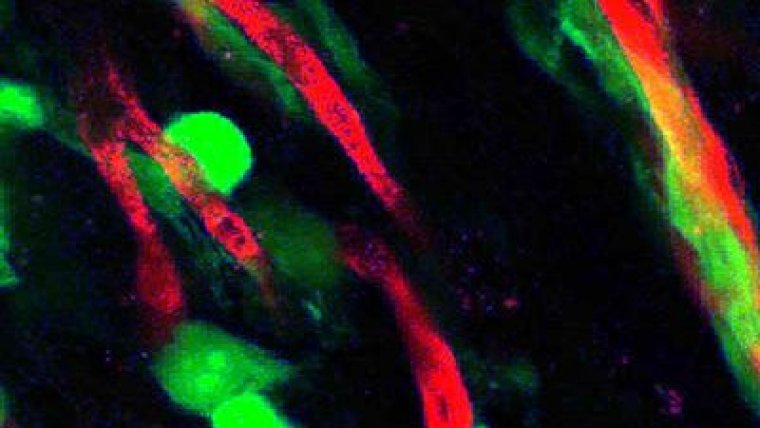| Health / Health News |
Brain tumor invasion along blood vessels may lead to new cancer treatments
NIH | JULY 8, 2014
Invading glioblastoma cells may hijack cerebral blood vessels during early stages of disease progression and damage the brain’s protective barrier, a study in mice indicates. This finding could ultimately lead to new ways to bring about the death of the tumor, as therapies may be able to reach these deadly cells at an earlier time point than was previously thought possible.

Attack of the glioma cells - Glioma cells (green) spread through the brain by taking control of blood vessels (red). Image courtesy of the Sontheimer Lab, University of Alabama at Birmingham.
Glioblastoma, a type of aggressive brain tumor, is one of the most devastating forms of cancer. These tumors spread quickly and are difficult to treat because the brain protects itself from foreign substances.
The blood-brain barrier (BBB) is designed to stand in the way of harmful materials leaking into the brain and to regulate the transport of important molecules back and forth between the brain and the blood. One component of the BBB is close-fitting connections (called tight junctions) that form seals between the blood vessel’s endothelial cells.
There are several other types of cells that cover the blood vessel, including specialized brain cells known as astrocytes, which have extensive projections, called endfeet, that cover 90 percent of the blood vessel surface.
The astrocytic endfeet release molecules that regulate the tight junctions between the endothelial cells. They also release specific chemicals that cause blood vessels to expand or contract, thereby regulating blood flow in the brain. As a whole, the BBB can be viewed as a smart protective wrapping that separates the blood from the brain.
Harald Sontheimer, Ph.D., from the University of Alabama at Birmingham, and his colleagues investigated the interactions between glioblastoma cells, astrocytes and cerebral blood vessels. They used mouse models of glioblastoma, fluorescent dyes and a variety of imaging techniques to see how tumor cells migrate through the brain and interact with other cells and blood vessels.
In the current study, the team showed that almost all of the glioblastoma cells outside the main tumor mass were located in the space between the astrocytic endfeet and the blood vessel outer surface. By using the meshwork of small blood vessels as a scaffold, glioblastoma cells were able to migrate along the vessels and extract nutrients from the blood for themselves.
In addition, the findings revealed the glioblastoma cells hijacked control over the blood flow by taking it away from the astrocytes. As a result, tight junctions became loose, which led to a breakdown in the BBB. Dr. Sontheimer and his colleagues were surprised that very small groups of tumor cells, even individual cells, were sufficient to weaken the BBB early in the disease process.
“Evidence from our models suggests that early in the disease, invading tumor cells are not completely protected by the blood-brain barrier and may be more vulnerable to drugs delivered to the brain via the blood. If these findings hold true in humans, treatment with anti-invasive agents might be beneficial in newly diagnosed glioblastoma patients,” said Dr. Sontheimer. He added that localized breaches in the BBB may allow regionally precise delivery of drugs to attack tumor cells even in the earliest stage.
YOU MAY ALSO LIKE


